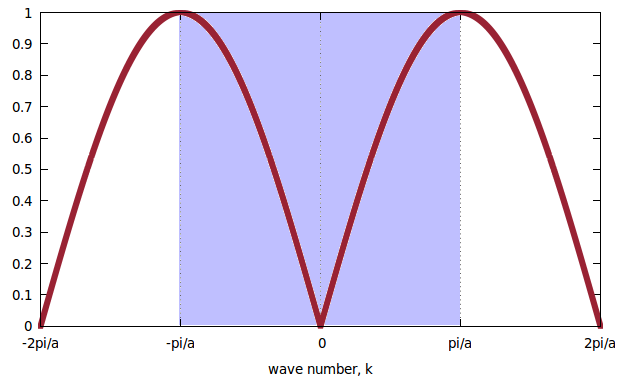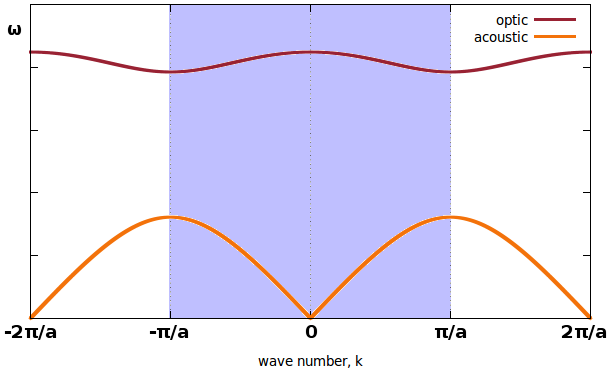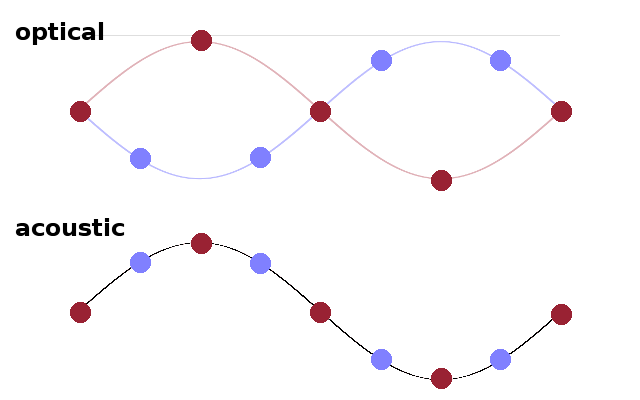

The wave number, $k$, is a measure of the spatial periodicity of a wave, i.e. the number of oscillations per length unit. It is therefore measured in ${\rm m^{-1}}$. Since a wave may travel in different directions, the wave number is the magnitude of the wave vector, $\vec{k}$. In spectroscopy, where the oscillating medium is electromagnetic radiation, the wave number is usually denoted as $\tilde{\nu}$, and there is a fixed relationship between the wave number ($\rm{m^{-1}}$) and the frequency ($\rm{s^{-1}}$): $$\nu=c\tilde{\nu}\qquad$$ where the speed of light acts as the constant of proportionality.
The "beads" of an electromagnetic wave have no rest mass, so they will be propagating at the speed of light. However, atoms in a crystal have a finite mass; therefore they travel at a lower speed, and the frequency of oscillation will become dependent on the wave number (and also on the direction of the wave vector). The relationship between frequency (usually expressed as an angular frequency, $\omega$) and wave number is known as a dispersion relation.
Just as the concept of photons is used to express the particle-like aspects of electromagnetic waves, the term phonon is used to refer to lattice vibrations where they behave in a particle-like manner. For example, when two oscillations along different lattice vectors meet and interact in a crystal, their interaction can be interpreted as two pseudo-particles, phonons, scattering off one another.

The monatomic chain model represents a crystal in one dimension where all atoms are identical, equally spaced in equilibrium and connected by bonds of equal strength. The mass of an atom is $m$, the spring constant, $C$, describes the strength of the bond between atoms, and we enumerate the atoms along the chain using a variable $s$ as a counter. The coordinate of atom $s$ along the chain is $x_s$.
The force $F_s$ acting on an atom $s$ at any given moment is the product of its mass and its acceleration: $$F_s=m\frac{{\rm d}^2x_s}{{\rm d}t^2}$$ As long as the displacement of the atom is elastic, i.e. no permanent deformation takes place, we can apply Hooke's law and express the force as the displacement times the spring constant, $C$. Since the neighbouring atoms $s-1$ and $s+1$ are also displaced from their equilibrium position, we need to consider the relative displacement between pairs:
$$F_s=C(x_{s-1}-x_s)+C(x_{s+1}-x_s)=C(x_{s+1}+x_{s-1}-2x_s)$$
This assumes, besides the validity of the elastic regime, that there are no long-range interactions between atoms that aren't immediately adjacent to one another.
The wave motion of the atoms is described by a complex exponential function in time with an angular frequency of $\omega$: $$x_s=A{\rm e}^{-{\rm i}\omega t}$$ By differentiating this twice
$$\frac{{\rm d}^2x_s}{{\rm d}t^2}=-{\rm i}\omega A\frac{\rm d}{{\rm d}t}{\rm e}^{-{\rm i}\omega t}={\rm i}^2\omega^2A{\rm e}^{-{\rm i}\omega t}=-\omega^2A{\rm e}^{-{\rm i}\omega t}=-\omega^2x_s$$
we can equate the two expressions for the force $F_s$ in an equation that depends only on the positions $x$ of adjacent atoms: $$-m\omega^2x_s=C(x_{s+1}+x_{s-1}-2x_s)$$
At the same time, we can also represent the oscillation of all the atoms in the chain at a given moment as a wave (complex exponential) in space with a wave number $k$: $$x_s=A{\rm e}^{{\rm i}ksa}$$ Here, $a$ is the equilibrium lattice spacing between the atoms. After substituting this into the equation, we have
$$-m\omega^2{\rm e}^{{\rm i}ksa}=C({\rm e}^{{\rm i}k(s+1)a}+{\rm e}^{{\rm i}k(s-1)a}-2{\rm e}^{{\rm i}ksa})=C{\rm e}^{{\rm i}ksa}({\rm e}^{{\rm i}ka}+{\rm e}^{-{\rm i}ka}-2)\qquad.$$

${\rm e}^{{\rm i}ksa}$ cancels out from both sides of the equation, and Euler's formula allows us to substitute the other two complex exponentials with a trigonometric function: $$-m\omega^2=2C(\cos(ka)-1)$$ This can be solved for $\omega^2$: $$\omega^2=\frac{2C}{m}\left(1-\cos(ka)\right)=\frac{4C}{m}\sin^2\left(\frac{ka}{2}\right)$$ and finally for $\omega$ to produce the dispersion relation for the monatomic chain. It is called a relation because of the absolute value appearing in the formula.
The figure above shows this dispersion relation. The vertical axis shows the frequency in units of the prefactor, $\sqrt{4C/m}$, while the wave number on the horizontal axis is normalised to the lattice spacing, $a$.

Every possible frequency occurs within the range from 0 to $\frac{\pi}{a}$. Including the negative half of the diagram (representing waves travelling in the opposite direction), this means that any wave number outside this range is indistinguishable from another oscillation within it. For example, the atoms shown in green in the figure on the right have the same displacements for both the short-wave oscillation (pink) and the long-wave oscillation (magenta). Since there are no atoms spaced closer together than the lattice spacing $a$, wave numbers larger than $\left|\frac{2\pi}{a}\right|$ will have more than one maximum within each atomic spacing.
The range of wave numbers from $-\frac{\pi}{a}$ to $\frac{\pi}{a}$ is known as the first Brillouin zone. Any wave vectors outside the first Brillouin zone can be mapped into it by adding an integer multiple of a reciprocal lattice vector; $\frac{\pi}{a}$ in the one-dimensional example.
In a travelling wave, the velocity of a particular feature of the wave (such as its maximum) is its phase velocity, $$v_p=\frac{\omega}{k}\qquad.$$ However, energy is transported by the wave at a generally slower speed, the group velocity, $$v_g=\frac{{\rm d}\omega}{{\rm d}k}\qquad,$$ i.e. the speed at which wave packets (beats) move.
Specifically, for the dispersion relation of the monatomic chain, this means
$$v_g=\frac{{\rm d}\omega}{{\rm d}k}=\frac{\rm d}{{\rm d}k}\sqrt{\frac{4C}{m}}\left|\sin\left(\frac{ka}{2}\right)\right|=\sqrt{\frac{4C}{m}}\left(\frac{a}{2}\right)\left|\cos\left(\frac{ka}{2}\right)\right|=a\sqrt{\frac{C}{m}}\left|\cos\left(\frac{ka}{2}\right)\right|$$
The cos term forces the group velocity down to zero at the edge of the first Brillouin zone ($k=\frac{\pi}{a}$), i.e. there is a standing wave with no net propagation in this limit.
The monatomic chain is a one-dimensional model representing the situation in a crystal with a primitive lattice, i.e. with only a single atom in the unit cell. An extension of the model to a more realistic three-dimensional case is achieved by replacing the wavenumber, $k$, with a wave vector, $\vec{k}$, with three components for the different directions of (reciprocal) space. At the same time, the lattice constant, $a$, is replaced with a unit cell vector, $\vec{r}$, with three components for the three directions of real space.

In the same way, we can use a one-dimensional diatomic chain model to represent centred lattices, where more than one atom is present in the unit cell. To preserve generality, we have to distinguish the two atoms and assign different masses to them: The positions of the two atom types are denoted by $u$ (shown in red) and $v$ (blue) and their masses by $M$ and $m$. We assume the spring constants for all bonds to be equal, $C$. Instead of individual atoms, the loop variable $s$ is now used to count unit cells (green), and the lattice parameter $a$ is now the distance between two identical atoms.
As in the monatomic case, we calculate the forces acting on atoms as a consequence of relative displacements between neighbours, taking account of the fact that neighbours are now of a different type and mass. For a 'red' atom of mass $M$, the force $F_u$ is the difference of its own displacement $u_s$ relative to its two neighbours, the 'blue' atoms in the same unit cell, $v_s$, and in the adjacent unit cell to the left, $v_{s-1}$: $$F_u=M\bbox[lightgreen]{\frac{{\rm d}^2u_s}{{\rm d}t^2}}=C(\bbox[lightblue]{v_s+v_{s-1}-2u_s})$$ In the same way, the force on the blue atom $v_s$ is: $$F_v=m\frac{{\rm d}^2v_s}{{\rm d}t^2}=C(u_{s+1}+u_s-2v_s)$$
The displacement of red and blue atoms can be described by waves in space and time: $$u_s=u{\rm e}^{{\rm i}ska}{\rm e}^{-{\rm i}\omega t}\qquad{\rm and}\qquad v_s=v{\rm e}^{{\rm i}ska}{\rm e}^{-{\rm i}\omega t}\qquad,$$ where $u$ and $v$ are the amplitudes of the oscillations of the two atoms, respectively.
For the left hand side of the force equation, this needs differentiating twice with respect to time:
$$\bbox[lightgreen]{\frac{{\rm d}^2u_s}{{\rm d}t^2}}=-{\rm i}\omega\frac{\rm d}{{\rm d}t}u_s=(-{\rm i}\omega)^2u_s=-\omega^2u_s=-\omega^2u{\rm e}^{{\rm i}ska}{\rm e}^{-{\rm i}\omega t}\qquad,$$
and the wave function can be inserted in the Hooke's law side of the equation, too:
$$\bbox[lightblue]{v_s+v_{s-1}-2u_s}=v{\rm e}^{{\rm i}ska}{\rm e}^{-{\rm i}\omega t}+v{\rm e}^{{\rm i}(s-1)ka}{\rm e}^{-{\rm i}\omega t}-2u{\rm e}^{{\rm i}ska}{\rm e}^{-{\rm i}\omega t}\qquad.$$
Doing this for both types of atom produces a pair of coupled equations, where the ${\rm e}^{-{\rm i}\omega t}$ and ${\rm e}^{{\rm i}ska}$ terms cancel out as they are common to each term of both equations: $$\left\{\begin{array}{lll} -\omega^2Mu&=&Cv(1+{\rm e}^{-{\rm i}ka})-2Cu\\ -\omega^2mv&=&Cu(1+{\rm e}^{{\rm i}ka})-2Cv \end{array}\right\}$$ These can be rearranged to put all terms on the left hand sides: $$\left\{\begin{array}{lll} (2C-\omega^2M)u-C(1+{\rm e}^{-{\rm i}ka})v&=&0\\ -C(1+{\rm e}^{{\rm i}ka})u+(2C-\omega^2m)v&=&0 \end{array}\right\}$$ and then rewritten as a determinant: $$\left|\begin{array}{cc} (2C-\omega^2M)&-C(1+{\rm e}^{-{\rm i}ka})\\ -C(1+{\rm e}^{{\rm i}ka})&2C-\omega^2m \end{array}\right|=0\qquad.$$ The determinant is solved by subtracting the second diagonal product from the first:
$$(2C-\omega^2M)(2C-\omega^2m)-(-C(1+{\rm e}^{-{\rm i}ka})(-C(1+{\rm e}^{{\rm i}ka})))=0\qquad.$$
Factoring out the two diagonal products:
$$4C^2-2C\omega^2m-2C\omega^2M+\omega^4Mm-C^2(1+{\rm e}^{-{\rm i}ka})(1+{\rm e}^{{\rm i}ka})=0$$
produces a quadratic equation in $\omega^2$:
$$Mm\omega^4-2C(M+m)\omega^2+4C^2-C^2(1+{\rm e}^{-{\rm i}ka}+{\rm e}^{{\rm i}ka}+\color{red}{\cancel{\color{black}{{\rm e}^{-{\rm i}ka+{\rm i}ka}}}^1})=0\qquad.$$
Euler's formula turns the first two exponentials into a cosine while the third exponential is equal to 1:
$$Mm\omega^4-2C(M+m)\omega^2+4C^2-C^2(2+2\cos{(ka)})=0\qquad.$$
Note that this eliminates all imaginary components - it has to, given that the frequency of the wave must be a real number. Some more rejigging is needed:
$$Mm\omega^4-2C(M+m)\omega^2+2C^2(1-\cos{(ka)})=0$$
before we can solve the quadratic equation for the roots of $\omega^2$:
$$\omega^2=\frac{2C(M+m)}{2Mm}\pm\sqrt{\frac{4C^2(M+m)^2}{4M^2m^2}-\frac{2C^2}{Mm}(1-\cos{(ka)})}\qquad.$$
Some more rejigging, involving the trigonometric identity $\cos{(2x)}=1-2\sin^2x$:
$$\omega^2=\frac{C(M+m)}{Mm}\pm C\sqrt{\frac{(M+m)^2}{M^2m^2}-\frac{4}{Mm}\sin^2{\left(\frac{ka}{2}\right)}}\qquad.$$
Finally, take the root again to produce the dispersion relation for the linear chain with alternating masses:
$$\omega(k)=\sqrt{\frac{C(M+m)}{Mm}\pm C\sqrt{\frac{(M+m)^2}{M^2m^2}-\frac{4}{Mm}\sin^2{\left(\frac{ka}{2}\right)}}}\qquad.$$
The $\pm$ under the (outer) root causes the appearance of two branches to the dispersion relation, an optical branch and an acoustic branch. This separation occurs for both longitudinal and transversal waves.
In order to understand the reason for the appearance of the optical branch, we can investigate the special case M=m:
$$\omega(k)=\sqrt{\frac{2Cm}{m^2}\pm C\sqrt{\frac{4m^2}{m^4}-\frac{4}{m^2}\sin^2\left(\frac{ka}{2}\right)}}=\sqrt{\frac{2C}{m}\left(1\pm\cos\left(\frac{ka}{2}\right)\right)}$$
The two branches remain even if the masses are the same. They are a consequence of the fact that the unit cell is no longer primitive but has an additional atom, i.e. it is a centred cell.

The dispersion relation produces the familiar arches with maxima and minima at the centre and at the edges of the first Brillouin zone. The acoustic branch behaves similar to the solution for the primitive (monatomic) linear chain, but the optical branch has the location its maximum and minimum swapped. This becomes obvious when calculating the frequencies for the two limiting cases.
At the centre of the first Brillouin zone,
k=0:
$$\omega(0)=\sqrt{\frac{C(M+m)}{Mm}\pm C\sqrt{\frac{(M+m)^2}{M^2m^2}-\frac{4}{Mm}\color{red}{\cancel{\color{black}{\sin^2(0)}}^0}}}$$ $$\qquad\qquad=\sqrt{\frac{C(M+m)}{Mm}\pm C\frac{M+m}{Mm}}$$ $$\qquad\qquad=\sqrt{\frac{2C(M+m)}{Mm}}=\sqrt{\frac{2C}{\mu}}\qquad\textrm{or}\qquad 0$$
Therefore the frequency of the acoustic branch is zero in this limit, while the frequency of the optical branch depends only on the spring constant and the reduced mass. Since the reduced mass, $\mu=\frac{mM}{m+M}$, is always smaller than either of the two interacting masses, this must be the absolute maximum of the frequency of the system.
At the boundary of the first Brillouin zone,
k=π/a:
$$\omega\left(\frac{\pi}{a}\right)=\sqrt{\frac{C(M+m)}{Mm}\pm C\sqrt{\frac{(M+m)^2}{M^2m^2}-\frac{4}{Mm}\color{red}{\cancel{\color{black}{\sin^2\left(\frac{\pi a}{2a}\right)}}^1}}}=\sqrt{\frac{C(M+m)}{Mm}\pm C\sqrt{\frac{(M+m)^2-4Mm}{M^2m^2}}}$$
The binomial formulae come in handy here:
$$\qquad\qquad=\sqrt{\frac{C(M+m)}{Mm}\pm C\sqrt{\frac{M^2+2Mm+m^2-4Mm}{M^2m^2}}}=\sqrt{\frac{C(M+m)}{Mm}\pm C\sqrt{\frac{(M-m)^2}{M^2m^2}}}$$ $$\qquad\qquad=\sqrt{\frac{C(M+m)}{Mm}\pm\frac{C(M-m)}{Mm}}=\sqrt{\frac{C}{Mm}(M+m\pm M\mp m)}$$ $$\qquad\qquad=\sqrt{\frac{2C}{m}}\qquad\textrm{or}\qquad\sqrt{\frac{2C}{M}}$$
The solutions depend on the spring constant and either the smaller or the larger mass. The solution based on the larger mass is the maximum of the acoustic branch, the solution based on the smaller mass the minimum of the optical branch. Note that there is a gap between the two branches where there are no frequencies for any value of the wave number. This is the phonon band gap.

For the acoustic branch, the two types of atoms oscillate in phase, effectively "riding" the same wave. This is the same pattern that a sound wave in a fluid medium would follow. On the other hand, the two types of atoms oscillate with opposite phase in the case of the optical branch. If the two types of atoms have opposite charges as well as different masses, the wave causes a charge separation because the positive charges are always displaced in the opposite direction to the negative charges. This is the kind of wave which can be excited using electromagnetic radiation, hence the name optical branch. This terminology is even used if the atoms aren't actually charged.
In the next section, we will consider the implications of phonons for the heat capacity of a solid.